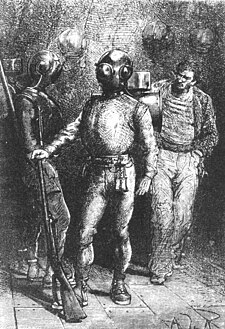Leyden ball

A Leyden ball is a fictional bullet used in the 19-century Jules Verne science fiction novel Twenty Thousand Leagues Under the Sea. It contains a capacitance charge of electrical energy, which discharges instantaneously upon the bullet's impact.
A similar, but more complex non-lethal electronic weapon, meant to disable people, has been developed for police use in the modern day.
Fictional description[edit]
In his 1870 science fiction classic Twenty Thousand Leagues Under the Sea, Jules Verne wrote about a hunting expedition using a very unusual form of bullet:[1]
the balls sent by this gun are not ordinary balls, but little cases of glass. These glass cases are covered with a case of steel, and weighted with a pellet of lead; they are real Leyden bottles, into which the electricity is forced to a very high tension. With the slightest shock they are discharged, and the animal, however strong it may be, falls dead.
In Verne's novel, the Leyden balls were fired with special rifles powered by compressed air; it was only necessary that they touch the target. It was even possible to use them to bag game flying mere feet above the waves:
I was witness to one of the finest gun shots which ever made the nerves of a hunter thrill. A large bird of great breadth of wing, clearly visible, approached, hovering over us. Captain Nemo's companion shouldered his gun and fired, when it was only a few yards above the waves. The creature fell stunned, and the force of its fall brought it within the reach of dexterous hunter's grasp. It was an albatross of the finest kind.
In real life[edit]
In 2005, the U.S. Department of Homeland Security awarded a development contract for a similar device called a Piezer, described as "an untethered electro-muscular disruption non-lethal stun weapon based on piezoelectric technology for civil law enforcement officers and the military".[2][3]
The Extended Range Electronic Projectile, a long-range untethered version of a rifle-fired Taser stun gun underwent trials in 2009. It was designed to fire non-lethal electronic dart modules at a range up to 20 meters from a 12-bore shotgun. Upon contact with its target, each dart module electrically shocks its subject for 20 seconds to immobilize it. The energy source for this device, however, is not a capacitor, but rather a conventional dry cell, or "battery".[4]
See also[edit]
References[edit]
- ↑ Twenty Thousand Leagues Under the Sea, A complete, unabridged translation of Vingt milles lieues sous les mers by Jules Verne, based on the original French texts published in Paris by J. Hetzel et Cie. over the period 1869–71. Translated from the Original French by F. P. Walter. Downloadable from the Internet Archive. Retrieved 2009-04-31.
- ↑ Christensen, Bill (2005-08-19). "Homeland Security Orders Modern Version of Jules Verne's Leyden Ball". LiveScience. Imaginova.com (from TechNovelgy.com). Retrieved 2009-05-11.
- ↑ Hambling, David (15 August 2005). "US Shoots Ahead In Stun Gun Design". New Scientist.
- ↑ "Long-Range Taser Reignites Safety Debate".
External links[edit]
- Leyden Ball description (TechNovelgy)
This article "Leyden ball" is from Wikipedia. The list of its authors can be seen in its historical and/or the page Edithistory:Leyden ball. Articles copied from Draft Namespace on Wikipedia could be seen on the Draft Namespace of Wikipedia and not main one.
